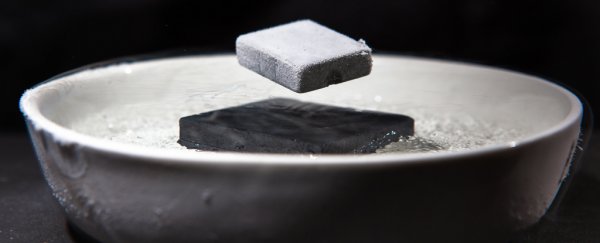At low temperatures, strontium titanate (SrTiO3) is able to conduct electricity without any resistance.
The fact it isn't a metal and can still accomplish this has long been a mystery. Now physicists have their first clues on why it defies current theories on superconducting materials, and it just might set the stage for a revolution in electronics.
New research lead by the US Department of Energy's SLAC National Accelerator Laboratory and Stanford University has found strontium titanate behaves in a weirdly opposite way to superconducting metals.
Ironically, it helps explain why it is a superconductor itself.
"This is a system where everything is upside down," says Stanford physicist Harold Hwang.
To understand this topsy-turvy nature of this crystalline substance, we need to step back and look at what conventionally makes a material conduct electricity with virtually zero effort.
For electrons to get from point A to point B, they usually need to jump through a jostling crowd of atoms under the pull of two different voltages.
Even if you chill the atoms into standing still, most materials will still tug on the stream of electrons to some degree, requiring energy to shove them through.
Superconductors are different. At a low-enough temperature, the nature of the atoms' arrangements allow them to jiggle in such a way that their electrons overcome their usual repulsion with one another to team up in what are known as Cooper pairs.
As partners, the two electrons share the same quantum state. It's this single-minded connection that helps them find the easiest path through the jungle of atoms, allowing them to effortlessly slip through their surroundings.
Thanks to their ability to play loose and fast with their electrons, metals make up the bulk of superconducting materials. In fact, for several decades after their discovery in 1911, there were no known non-metallic superconductors.
Strontium titanate changed that. In the 1960s this odd oxide was found to have superconducting properties when, by all accounts, it shouldn't.
"It's one of a large number of materials we call 'unconventional' superconductors because they can't be explained by current theories," says lead author Adrian Swartz from the Stanford Institute for Materials and Energy Science.
"By studying its extreme behaviour, we hope to gain insight into the ingredients that lead to superconductivity in these unconventional materials, including the ones that operate at higher temperatures."
Being able to conduct electricity resistance-free without needing to waste energy on dropping the temperature would be a huge boost to electronics.
So to better understand exactly how strontium titanate worked, the researchers analysed the behaviour of its atoms using tunnelling spectroscopy. This method determines the energy of a material's discrete components - almost like having a tiny finger sense the positions and energies of particles in a material.
Though it sounds simple in principle, the investigation has required technology and investigative processes to catch up.
"The desire to do this experiment has been there for decades, but it's been a technical challenge," says Hwang.
It's well worth the wait, it seems. The tiny 'finger' detected something remarkable about strontium titanate's structure.
Where superconducting metals have atoms that hum weakly, and plenty of electrons to pair up and slip through the shaking crowd, strontium titanate is kind-of the opposite.
It might not have as many free electrons, but its lattice of atoms have a far stronger vibration - and the end result still lines up perfectly with superconducting theory.
"Thus, strontium titanate seems to be an unconventional superconductor that acts like a conventional one in some respects," says Hwang.
Recently, graphene has been the wonder-material that's captured the attention of physicists studying non-metallic superconductors. Clearly, there's plenty of room for more research on this exciting field.
With their tunnelling spectroscopy tech on game, the team plans to continue to probe strontium titanate unusual properties even further, hopefully building on ideas that could one day lead to a new kind of conduction.
This research was published in PNAS.
